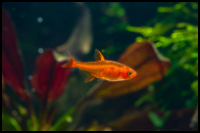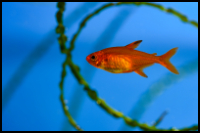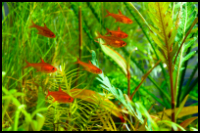




Quick Care Details (Table)
| Livestock Characteristics | Value |
|---|---|
| Care Level | Easy |
| Temperament | Peaceful |
| Diet | Omnivore |
| Maximum Size | 1 Inch |
| Minimum Tank Size | 10 gallons |
| Plant Safe | Yes |
| Temperature Range | 73°F - 84°F (23°C - 29°C) |
| PH Range | 5.5 - 7.0 |
| KH Range | 1 - 10 dKH |
| GH Range | 5 - 12 dGH |
Species Specific Categories
Helpful Video
Care Details
Aquascape: When setting up for Ember Tetras, think densely planted tanks with open swimming areas. Include floating plants for shade and driftwood for hiding spots.
Substrate: Use fine gravel or sand as substrate; it mimics their natural habitat and allows for easy rooting of plants.
Disease Prevention: Maintain clean water conditions, regular water changes, and quarantine new fish to prevent diseases from spreading.
Filtration: Opt for gentle filtration to avoid strong currents; Ember Tetras prefer calmer waters.
Lighting: Moderate lighting is ideal, especially if you have live plants. Avoid intense or direct light.
Water Flow: Gentle water flow is preferred; these fish thrive in slower-moving waters.
Hardiness: Embers are hardy once acclimated, but sudden changes in water parameters can stress them.
Acclimation: Slowly acclimate them to tank conditions to prevent shock.
Expected Lifespan: They typically live around 3-4 years, sometimes longer with proper care.
Special Requirements: Regular water checks, suitable tank mates, and a well-established tank are crucial.
Temperament and Behavior
Behavior: Peaceful and active in a group; they love exploring and swimming in shoals.
Breeding: They scatter eggs among plants, and adult fish might eat the eggs, so consider a separate breeding tank.
Aggression: Very minimal aggression; they're peaceful community fish.
Tankmates Compatibility: Great tank mates include small, peaceful fish like other small tetras, rasboras, or peaceful dwarf shrimp.
Activity Level: Active swimmers, especially in groups; they're most vibrant when comfortable.
Schooling or Shoaling Behavior: Thrive in groups of 8-10 or more; they feel secure and display more natural behavior.
Plant Compatibility: They appreciate planted tanks; use hardy plants like Java Fern or Anubias.
Diet and Nutrition
Dry Foods: They accept high-quality flakes or micro-pellets; ensure they are small enough for their small mouths.
Frozen Foods: Enjoy live or frozen foods like bloodworms and brine shrimp as occasional treats.
Live Foods: They relish live foods such as daphnia and small insects.
Vegetables: While not a significant part of their diet, they might nibble on blanched vegetables like spinach or zucchini.
Algae: They may graze on algae in the tank, but it shouldn't be their primary food source.
Feeding Schedule: Feed small amounts multiple times a day to mimic their natural grazing behavior.
Supplemental Foods: Occasionally provide treats like live or frozen foods to enhance their diet.
Tank Parameters
Tank size: A minimum of 10 gallons is suitable for a small group of Ember Tetras.
Tank Length and Measurements: Opt for longer tanks over taller ones to accommodate their swimming habits.
Water Temperature: Keep the temperature between 73°F - 84°F (23°C - 29°C).
pH (Acidity/Alkalinity): Maintain a pH range of 5.5 - 7.0.
KH (Carbonate Hardness): Between 1 - 10 dKH.
GH (General Hardness): Keep it within 5 - 12 dGH.
Nitrate (NO3) levels: Keep nitrate levels low through regular water changes.
History, Popularity, History and Species Variety Details
The History, Popularity, and Natural Habitat
History: Ember Tetras were discovered fairly recently in the 1980s in Brazil and gained popularity due to their stunning appearance and suitability for smaller tanks.
Popularity: They've become highly sought after due to their vibrant colors, peaceful nature, and suitability for nano aquariums.
Natural Habitat: They hail from shallow, slow-moving streams and tributaries within the Amazon Basin, often among densely vegetated areas.
Back to topSimilar or Variations of the Species
- Celestial Pearl Danios (Danio margaritatus): These small, colorful fish, also known as Galaxy Rasboras or Microrasboras, are native to Southeast Asia. They have stunning blue and red hues, similar to the Ember Tetras, and are known for their peaceful nature. Celestial Pearl Danios prefer planted tanks and appreciate similar water parameters to Ember Tetras. They are active swimmers and enjoy being in shoals.
- Chili Rasboras (Boraras brigittae): Like Ember Tetras, Chili Rasboras are vibrant and small-sized fish. They showcase a striking red coloration and are incredibly peaceful, making them suitable for community tanks. These fish also prefer densely planted aquariums with subdued lighting. They tend to thrive in groups and exhibit shoaling behavior, similar to Ember Tetras.
- Dwarf Rasboras: This is a collective term encompassing various small Rasbora species like the Mosquito Rasbora (Boraras brigittae), the Harlequin Rasbora (Trigonostigma heteromorpha), and the Exclamation Point Rasbora (Boraras urophthalmoides). These Rasboras, much like Ember Tetras, are peaceful, small-sized, and have attractive coloration. They enjoy planted tanks, exhibit schooling behavior, and are compatible with similar tank conditions as Ember Tetras.
Frequently Asked Questions
What size tank do Ember Tetras need?
Ember Tetras are small but active. A 10-gallon tank is ideal for a small group of 8-10 tetras, providing ample swimming space.
How many Ember Tetras should I keep together?
They're social fish. A group of 8-10 or more enhances their comfort and brings out their natural behaviors beautifully.
What's the secret to maintaining their vibrant color?
Balanced nutrition, good water quality, and a stress-free environment are key. High-quality foods and regular water changes help retain their stunning colors.
Do Ember Tetras need lots of plants in their tank?
They appreciate densely planted tanks as it mimics their natural habitat. Plants provide hiding spots and security, contributing to their well-being.
Can Ember Tetras live with other fish in a community tank? Any problematic tank mates?
They're peaceful and mix well with other small, non-aggressive fish like rasboras, small peaceful tetras, and dwarf shrimp. Avoid larger or aggressive species.
What's the best diet for Ember Tetras?
They accept high-quality flakes or micro-pellets. Supplement with live or frozen foods like bloodworms and brine shrimp to vary their diet.
Are Ember Tetras prone to diseases?
They're generally hardy, but poor water conditions can stress them. Maintain good water quality and consider quarantining new fish to prevent diseases.
How do you encourage breeding behavior in Ember Tetras?
Provide plenty of plants for egg scattering, maintain stable water conditions, and a separate breeding tank might be necessary to protect the eggs.
What are the preferred water parameters for Ember Tetras?
They thrive in slightly acidic to neutral water (pH 5.5 - 7.0), with soft to moderately hard water (KH: 1 - 10, GH: 5 - 12).
How do you acclimate Ember Tetras to a new tank?
Slowly introduce them to the tank's water by drip acclimation over 30-60 minutes, minimizing stress from sudden changes in water parameters.

